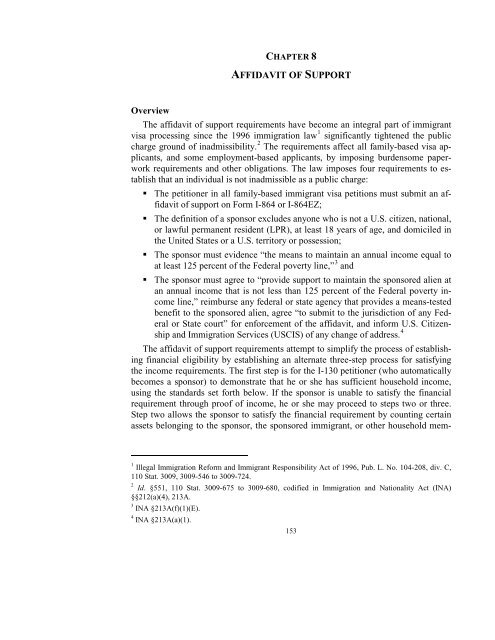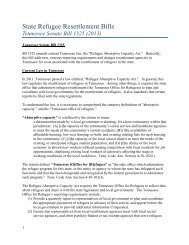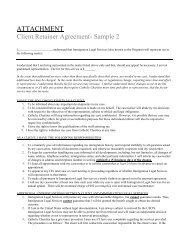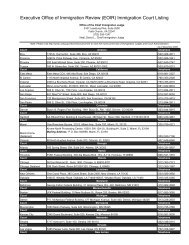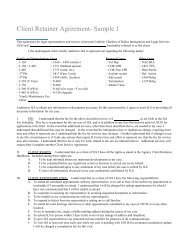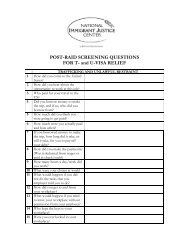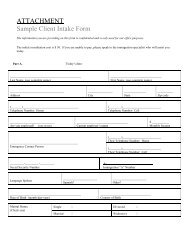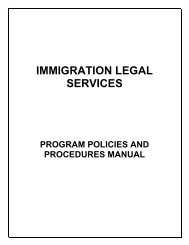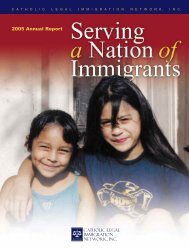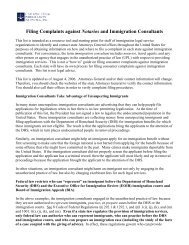You also want an ePaper? Increase the reach of your titles
YUMPU automatically turns print PDFs into web optimized ePapers that Google loves.
CHAPTER 8AFFIDAVIT OF SUPPORTOverviewThe <strong>affidavit</strong> <strong>of</strong> <strong>support</strong> requirements have become an integral part <strong>of</strong> immigrantvisa processing since the 1996 immigration law 1 significantly tightened the publiccharge ground <strong>of</strong> inadmissibility. 2 The requirements affect all family-based visa applicants,and some employment-based applicants, by imposing burdensome paperworkrequirements and other obligations. The law imposes four requirements to establishthat an individual is not inadmissible as a public charge:• The petitioner in all family-based immigrant visa petitions must submit an <strong>affidavit</strong><strong>of</strong> <strong>support</strong> on Form I-864 or I-864EZ;• The definition <strong>of</strong> a sponsor excludes anyone who is not a U.S. citizen, national,or lawful permanent resident (LPR), at least 18 years <strong>of</strong> age, and domiciled inthe United States or a U.S. territory or possession;• The sponsor must evidence “the means to maintain an annual income equal toat least 125 percent <strong>of</strong> the Federal poverty line,” 3 and• The sponsor must agree to “provide <strong>support</strong> to maintain the sponsored alien atan annual income that is not less than 125 percent <strong>of</strong> the Federal poverty incomeline,” reimburse any federal or state agency that provides a means-testedbenefit to the sponsored alien, agree “to submit to the jurisdiction <strong>of</strong> any Federalor State court” for enforcement <strong>of</strong> the <strong>affidavit</strong>, and inform U.S. Citizenshipand Immigration Services (USCIS) <strong>of</strong> any change <strong>of</strong> address.4The <strong>affidavit</strong> <strong>of</strong> <strong>support</strong> requirements attempt to simplify the process <strong>of</strong> establishingfinancial eligibility by establishing an alternate three-step process for satisfyingthe income requirements. The first step is for the I-130 petitioner (who automaticallybecomes a sponsor) to demonstrate that he or she has sufficient household income,using the standards set forth below. If the sponsor is unable to satisfy the financialrequirement through pro<strong>of</strong> <strong>of</strong> income, he or she may proceed to steps two or three.Step two allows the sponsor to satisfy the financial requirement by counting certainassets belonging to the sponsor, the sponsored immigrant, or other household mem-1 Illegal Immigration Reform and Immigrant Responsibility Act <strong>of</strong> 1996, Pub. L. No. 104-208, div. C,110 Stat. 3009, 3009-546 to 3009-724.2 Id. §551, 110 Stat. 3009-675 to 3009-680, codified in Immigration and Nationality Act (INA)§§212(a)(4), 213A.3 INA §213A(f)(1)(E).4 INA §213A(a)(1).153
ers. If the sponsor cannot demonstrate sufficient income or assets, the third step issecuring a joint sponsor (cosponsor) who can satisfy the financial requirements.This <strong>chapter</strong> will provide an analysis <strong>of</strong> the <strong>affidavit</strong> <strong>of</strong> <strong>support</strong> requirements andForm I-864, Affidavit <strong>of</strong> Support Under Section 213A <strong>of</strong> the Act; I-864A, ContractBetween Sponsor and Household Member; and Form I-864W, Intending Immigrant’sAffidavit <strong>of</strong> Support Exemption. Form I-864EZ, Affidavit <strong>of</strong> Support Under Section213A <strong>of</strong> the Act, may be used in lieu <strong>of</strong> the longer I-864 when the sponsor is petitioningfor only one family member, is employed (not self-employed), will satisfy thefinancial requirements with income (not assets), and will be using only his or her income(not using other household members or joint sponsors) to satisfy the financialrequirements. Every reference to the I-864 in this <strong>chapter</strong> should be considered toinclude the alternative I-864EZ where appropriate.Mandatory Filing RequirementWho Is AffectedThe statute requires almost all family-based visa applicants to submit the I-864 <strong>affidavit</strong><strong>of</strong> <strong>support</strong> as a condition <strong>of</strong> admissibility. 5 Employment-based immigrant visaapplicants are required to submit an <strong>affidavit</strong> if the applicant’s relative either filed theForm I-140, Immigrant Petition for Alien Worker, or has a significant (five percent)ownership interest in the business entity that filed the petition. 6For family-based petitions, the <strong>affidavit</strong> requirement affects intending immigrantswho “seek admission or adjustment <strong>of</strong> status under a visa number issued under section201(b)(2) or 203(a)” <strong>of</strong> the Immigration and Nationality Act (INA). These twosections define eligibility for a family-based visa by categorizing the applicant as eitheran “immediate relative” <strong>of</strong> the petitioner or as fitting within one <strong>of</strong> the four “preference”categories.The process for immigrating a family member is initiated by the U.S. citizen’s orLPR’s completing and filing a Form I-130, Petition for Alien Relative. At the timethe intending immigrant files for either adjustment <strong>of</strong> status or an immigrant visa, thepetitioner on the I-130 must execute and file an <strong>affidavit</strong> <strong>of</strong> <strong>support</strong>. The term “intendingimmigrant” is defined in the final regulation as “any beneficiary <strong>of</strong> an immigrantvisa petition filed under section 204 <strong>of</strong> the [INA], including any alien who will7accompany or follow-to-join the principal beneficiary.” In other words, the petitionermust submit an <strong>affidavit</strong> <strong>of</strong> <strong>support</strong> for the principal beneficiary designated on theI-130, as well as for the beneficiary’s family members who will be immigrating underthe same immigrant visa category. If the principal beneficiary is immigrating throughone <strong>of</strong> the preference categories, his or her spouse and children may be granted an5 INA §212(a)(4)(C)(ii).6 INA §§212(a)(4)(D), 213A(f)(4)(A).7 8 CFR §213a.1.154
immigrant visa also. That derivative family member could be applying at the sametime or within six months <strong>of</strong> the principal beneficiary (accompanying) or more thansix months later (following-to-join).If the petitioner cannot demonstrate sufficient income or assets, as described below,then the petitioner has the right to obtain a joint sponsor who does satisfy theincome requirements and agrees to be jointly and severally liable with the petitioner.Who Is Not AffectedThe <strong>affidavit</strong> <strong>of</strong> <strong>support</strong> is only required for persons seeking a family-based (and inlimited circumstances an employment-based) immigrant visa. Therefore, the followingimmigrant visa applicants are not affected by the <strong>affidavit</strong> <strong>of</strong> <strong>support</strong> requirement:• Applicants under the Cuban Adjustment Act• Applicants under the Nicaraguan Adjustment and Central American Relief Act• Applicants under the Haitian Refugee Immigration Fairness Act• Special immigrant juveniles• Diversity visa lottery applicants• Persons granted asylum or refugee status• Registry applicants• Persons adjusting based on being granted cancellation <strong>of</strong> removal, or suspension<strong>of</strong> deportationThe regulations also specify that the <strong>affidavit</strong> <strong>of</strong> <strong>support</strong> requirement does not applyto widows and widowers applying for immigrant status based on prior marriage to aU.S. citizen. 8 Nor does it apply to battered spouses and children filing self-petitionsbased on a relationship to a U.S. citizen or LPR spouse or parent who was responsiblefor the battery or extreme cruelty. 9 These applicants, however, must submit a Form I-864W, Intending Immigrant’s Affidavit <strong>of</strong> Support Exemption. 10 The <strong>affidavit</strong> <strong>of</strong> <strong>support</strong>requirement does not apply to nonimmigrant visa applicants, such as those seekinga K or V visa. Fiancé(e)s who enter the United States on a K-1 visa and then marry theU.S. citizen petitioner within 90 days are allowed to file directly for adjustment <strong>of</strong> status.11 They must submit an I-864 at the time they file for LPR status. 12There is an important exemption for intending immigrants who already have acquired40 “qualifying quarters.” 13 A qualifying quarter is a legal term relating to a8 8 CFR §213a.2(a)(2)(ii)(A).9 Id.10 8 CFR §213a.2(a)(1)(i)(B).11 INA §245(d).12 8 CFR §§213a.2(a)(2)(i)(A), (b)(1).13 INA §213A(a)(3)(B).155
unit <strong>of</strong> wage that, if earned in most types <strong>of</strong> employment, counts toward coverage forSocial Security benefits. One earns up to four qualifying quarters in a calendar year.But the spouse and child may also be credited with the quarters earned by the spouseor parent: spouses may be credited with all the quarters earned by the other spouseduring marriage, assuming the marriage did not end in divorce; children may be creditedwith all quarters earned by either or both parents until the child turns 18. Sincethe <strong>affidavit</strong> <strong>of</strong> <strong>support</strong> requirements terminate when the sponsored immigrant earnsor is credited with 40 qualifying quarters, intending immigrants who demonstratethrough Social Security earnings statements that they have already satisfied that requirementdo not have to submit an <strong>affidavit</strong> <strong>of</strong> <strong>support</strong>. Instead, they submit a FormI-864W and include a copy <strong>of</strong> the wage earner’s Social Security earnings record.An exemption also applies for children who will be deriving citizenship status pursuantto the Child Citizenship Act <strong>of</strong> 2000 immediately upon immigrating or adjustingstatus because they are under 18 and residing with at least one U.S. citizen parent. 14These children will submit the Form I-864W in lieu <strong>of</strong> the <strong>affidavit</strong> <strong>of</strong> <strong>support</strong>.When Must the Affidavit Be FiledThe <strong>affidavit</strong> must be filed at the time an intending immigrant is applying for animmigrant visa or adjustment <strong>of</strong> status.15 Since all family-based adjustment applicationsare now filed with the National Benefits Center (NBC) via the Chicago Lockbox,the I-864 must be submitted together with the Form I-485 and accompanyingdocuments. Legacy Immigration and Naturalization Service (INS) stated in a 2000policy memo that the <strong>affidavit</strong> <strong>of</strong> <strong>support</strong> must be legally sufficient at the time theadjustment <strong>of</strong> status application was approved, not at the time the <strong>affidavit</strong> wasfiled. 16 That policy allowed adjustment applicants to submit an <strong>affidavit</strong> <strong>of</strong> <strong>support</strong>showing income below the required level, provided they supplemented it at the adjustmentinterview showing pro<strong>of</strong> <strong>of</strong> sufficient income. USCIS, however, has reversedits position on this issue, and has now determined that the <strong>affidavit</strong> must besufficient both at the time <strong>of</strong> filing and at the time the adjustment application is adjudicated.17 The NBC is following that policy when it vets the <strong>affidavit</strong> <strong>of</strong> <strong>support</strong> aspart <strong>of</strong> the process <strong>of</strong> preparing the adjustment application for adjudication. BeginningNovember 23, 2005, all adjustment applications had to be filed centrally andmust include the I-864. 18 If processing at a U.S. consular <strong>of</strong>fice, the applicant must14 8 CFR §213a.2(a)(2)(ii)(E).15 8 CFR §213a.2(a)(1)(ii).16 INS Memorandum, M. Cronin, “Clarification <strong>of</strong> Service Policy Concerning I-864 Affidavit <strong>of</strong> Support”(Mar. 7, 2000).17USCIS Memorandum, M. Aytes, “Consolidation <strong>of</strong> Policy Regarding USCIS Form I-864, Affidavit<strong>of</strong> Support (AFM Update AD06-20)” (June 27, 2006), published on AILA InfoNet at Doc. No.06063013 (posted June 30, 2006).18 USCIS Memorandum, M. Aytes, “USCIS Policy Regarding Form I-864, Affidavit <strong>of</strong> Support” (Nov.23, 2005), published on AILA InfoNet at Doc. No. 05120210 (posted Dec. 2, 2005).156
submit the I-864 to either the National Visa Center or the consulate as part <strong>of</strong> the instructionpackage processing.Definition <strong>of</strong> SponsorAccording to the statute, to qualify as a sponsor, one must satisfy three basic eligibilityrequirements. A sponsor must be:• a U.S. citizen, national, or LPR;• at least 18 years <strong>of</strong> age; and• domiciled within the United States or in any U.S. territory or possession. 19There are no exceptions to these requirements. While a petitioner who is unable tosatisfy the income requirements can obtain a joint sponsor who can satisfy them, thisis not true for the citizenship/immigration status, age, and domicile requirements.Every sponsor and joint sponsor must satisfy these basic prerequisites.Citizen, National, or Lawful Permanent ResidentSince the sponsor must be a citizen, national, or LPR, the sponsor must be a naturalperson, and cannot be a corporation or other entity. Joint sponsors or relatives in employment-basedpetitions who are LPRs must submit pro<strong>of</strong> <strong>of</strong> that status with the I-864.The citizen/LPR requirement will not affect those family-based petitioners whocan satisfy the income requirements, since in order to immigrate a family member,the petitioner must be a citizen or LPR. However, for those petitioners who must obtaina joint sponsor, this requirement may serve to reduce the potential pool further.For example, nonimmigrants cannot serve as joint sponsors.Domiciled in the United StatesThe sponsor must be domiciled in “any <strong>of</strong> the several States <strong>of</strong> the United States,the District <strong>of</strong> Columbia, or any territory or possession <strong>of</strong> the United States.” 20 Thisrequirement could prevent some U.S. citizens or LPRs residing outside the UnitedStates from filing a visa petition on behalf <strong>of</strong> another family member. To overcomethis hurdle, it is important to read closely the definition <strong>of</strong> “domicile” and “residence,”as well as the exceptions set forth in the interim regulation.A domicile is defined as “the place where a sponsor has his or her principal residence,as defined in section 101(a)(33) <strong>of</strong> the [INA], with the intention to maintain thatresidence for the foreseeable future.”21 Residence, in turn, is defined as the person’s“place <strong>of</strong> general abode,” or the “principal, actual dwelling place in fact, without regardto intent.” 22 Taken together, this means that sponsors residing temporarily outside the19 INA §213A(f)(1).20 INA §213A(f)(1)(C).21 8 CFR §213a.1.22 INA §101(a)(33).157
United States can still qualify to submit an I-864, provided they have a residence in theUnited States that they use as their “principal, actual dwelling place.”The term “United States” includes Puerto Rico, Guam, and the Virgin Islands. 23The terms “territory” or “possession” are not specifically defined in the INA, but theterm “outlying possession” is defined to include only American Samoa and theSwains Island. 24 In addition, the Northern Mariana Islands should be considered aterritory or possession.LPRs living abroad temporarily will be considered domiciled in the United States ifthey apply for and obtain the “preservation <strong>of</strong> residence” benefit set forth in INA25§§316(b) or 317. Section 316(b) relates to LPRs who have been present in the UnitedStates for at least one year after being admitted for permanent residence, but who contemplatebeing outside the United States for more than one year. To qualify for thisbenefit, the LPR must be employed or under contract with any <strong>of</strong> the following:• The U.S. government• An American institution <strong>of</strong> research recognized by the U.S. attorney general• An American firm or corporation engaged in whole or in part in the development<strong>of</strong> foreign trade and commerce <strong>of</strong> the United States• A subsidiary <strong>of</strong> the above firm or corporation, more than 50 percent <strong>of</strong> whosestock is owned by an American firm or corporation, or• A public international organization <strong>of</strong> which the United States is a member bytreaty or statute and by which the person was not employed until after being anLPR.In addition, the LPR must establish that the absence from the United States is onbehalf <strong>of</strong> the employer and for the purpose set forth in the employment.INA §317 relates to persons who are authorized to perform the ministerial orpriestly functions <strong>of</strong> a religious denomination having a bona fide organization withinthe United States. Alternatively, they could be engaged as a missionary, brother, nun,or sister by a religious denomination or by an interdenominational mission organizationhaving a bona fide organization within the United States. To qualify for this exception,the LPR must have been physically present and residing in the United Statesfor at least one year prior to engaging in the above activities abroad, and their absencemust have been for the purpose <strong>of</strong> performing these activities.23 INA §101(a)(38).24 INA §101(a)(29).25 8 CFR §213a.2(c)(1)(ii)(A).158
A citizen living abroad temporarily also may be considered domiciled in the UnitedStates if the person’s employment meets requirements similar to those set forthabove. 26 To qualify, the employment must be with one <strong>of</strong> the following: 27• The U.S. government• An American institution <strong>of</strong> research recognized by the U.S. attorney general• An American firm or corporation engaged in whole or in part in the development<strong>of</strong> foreign trade and commerce <strong>of</strong> the United States• A subsidiary <strong>of</strong> the above firm or corporation, or• A public international organization <strong>of</strong> which the United States participates bytreaty or statute.Alternatively, the citizen may be: 28• Authorized to perform the ministerial or priestly functions <strong>of</strong> a religious denominationhaving a bona fide organization within the United States, or• Engaged solely as a missionary by a religious denomination or by an interdenominationalmission organization having a bona fide organization within theUnited States.If the citizen’s or LPR’s employment does not fall within the above exceptions, heor she will have to return to the United States and establish a domicile in this countrybefore being able to qualify as a sponsor. Sponsors who are domiciled abroad neverthelessmay submit an <strong>affidavit</strong> <strong>of</strong> <strong>support</strong> if they convince USCIS or the consular<strong>of</strong>ficial that they will re-establish domicile in the United States on or before the datethe intending immigrant obtains LPR status. 29 Sponsors who are U.S. citizens andwho are accompanying the intending immigrant to the port-<strong>of</strong>-entry will be deemedto have established domicile in the United States; sponsors who are LPRs will bedeemed similarly unless the LPR is denied admission to the country. 30Consequences <strong>of</strong> Petitioner’s DyingLegislation enacted at the end <strong>of</strong> 2009 allows certain surviving family memberswho were residing in the United States at the time the petitioner died and who continueto reside here to have their pending I-130 petition or adjustment application31adjudicated as if the petitioner were still alive. If the petition was previously approved,it will not be subject to automatic revocation upon the death <strong>of</strong> the petitioner.26 Id.27 INA §319(b)(1).28 Id.29 8 CFR §213a.2(c)(1)(ii)(B).30 Id.31 FY10 DHS Appropriations Act, Pub. L. No. 111-83, 123 Stat. 2142, §568(d), October, 28, 2009,adding INA §204(l).159
In addition, regulations pre-existing this statutory change provide relief for those whodo not meet these residency requirements. The beneficiary may request that USCISreinstate a petition that was automatically revoked upon the petitioner’s death if suchrevocation would be “inappropriate” based on humanitarian grounds. 32 This form <strong>of</strong>relief, referred to as humanitarian reinstatement, would be available to those beneficiariesresiding abroad or residing there at the time the petitioner died, while the newstatutory benefit would apply to those residing here.In both situations, however, the beneficiary must submit a substitute <strong>affidavit</strong> <strong>of</strong><strong>support</strong> from another close relative. Family members <strong>of</strong> the intending immigrant whocan act as substitute sponsors include the spouse, parent, mother-in-law, father-inlaw,sibling, child (at least 18 years old), son, daughter, son-in-law, daughter-in-law,33sister-in-law, brother-in-law, grandparent, grandchild, or legal guardian. If filing asa substitute sponsor, check box 1f in Part 1 <strong>of</strong> the I-864 and submit pro<strong>of</strong> <strong>of</strong> the relationshipto the intending immigrant.Legally Enforceable ContractThe statute provides that the <strong>affidavit</strong> will be legally enforceable against the sponsorin actions brought by either the sponsored immigrant or a federal, state, or “other34entity” that provides a means-tested benefit to the alien. In other words, the sponsoredimmigrant can sue the sponsor to enforce the maintenance agreement. In addition,should the immigrant ever obtain a means-tested benefit, the agency or entitythat provided it can also seek reimbursement from the sponsor.Enforceable by the Sponsored ImmigrantAfter adjustment <strong>of</strong> status or admission to the United States as an LPR, the sponsoredimmigrant can require the sponsor to maintain him or her at “an annual incomethat is not less than 125 percent <strong>of</strong> the Federal poverty line.”35 Even persons on activeduty in the U.S. Armed Forces, who must only demonstrate the means to maintainan annual income equal to 100 percent <strong>of</strong> the poverty line, 36 must agree to maintainthe sponsored immigrant at this level. It has been interpreted to mean that thesponsor must provide <strong>support</strong> equivalent to 125 percent <strong>of</strong> the poverty line for afamily <strong>of</strong> one. 37 Based on the 2012 federal poverty guidelines, 38 this amounts to$13,962.32 8 CFR §205.1(a)(3)(i)(C).33 INA §213A(f)(5)(B).34 INA §213A(e).35 INA §213A(a)(1)(A).36 INA §213A(f)(3).37 Stump v. Stump, 2005 U.S. Dist. LEXIS 26022 (N.D. Ind. Oct. 25, 2005).38 See discussion, infra.160
Where the sponsor executed <strong>affidavit</strong>s <strong>of</strong> <strong>support</strong> for other family members whoaccompanied the principal beneficiary, it is also unclear whether the sponsor mustmaintain each immigrant at the $13,962 level (based on the 2012 guidelines) orwhether he or she can add them together and apply the household formula. In otherwords, where the person sponsored a total <strong>of</strong> four immigrants, must the sponsormaintain each immigrant at the $13,962 level (for a total <strong>of</strong> $55,848) or may thesponsor satisfy the requirement by maintaining them collectively at the 125 percentlevel for a household <strong>of</strong> four ($28,812, based on 2012 guidelines)? Until the courts orUSCIS provides clarification, we should assume that the sponsor is obligated tomaintain each sponsored immigrant at the $13,962 level.The sponsor can provide either cash or in-kind benefits. The sponsor should beable to satisfy the maintenance requirement by providing housing, food, or clothes inlieu <strong>of</strong> cash. Also, the sponsor should be able to reduce the amount <strong>of</strong> <strong>support</strong> by anyincome or benefits the sponsored immigrant is receiving from other sources. For example,if the sponsored immigrant is working and earning an annual income <strong>of</strong>$5,000, the sponsor must only provide, based on the 2012 guidelines, maintenanceequivalent to $8,962. It is unclear at this point whether the sponsored alien has anaffirmative duty to mitigate damages. The one case that addressed this issue determinedthat the sponsored alien had sought employment to mitigate damages, thoughthe court failed to hold that the plaintiff had a duty to do so. 39When there is a sponsor and a joint sponsor, they each accept joint and severalliability to maintain the sponsored immigrant at the 125 percent <strong>of</strong> poverty level. 40For example, in 2012 the sponsor and joint sponsor must collectively ensure that thesponsored immigrant is receiving a minimum <strong>of</strong> $13,962. The sponsored immigrantcan elect to enforce the <strong>affidavit</strong> agreement against either the sponsor or the jointsponsor. However, he or she can collect a judgment only up to the 125 percent <strong>of</strong> thepoverty line.Enforceable by a Federal, State, or Other EntityIf the sponsored immigrant receives a means-tested benefit, the agency or entitythat provided it may seek reimbursement from the sponsor. This means that shouldthe immigrant suffer a debilitating injury or illness, the sponsor could be required toreimburse the full amount <strong>of</strong> any means-tested medical, cash, or in-kind benefits paidby the government agency or entity.The term “federal means-tested program” has been defined to include only five programs:Supplemental Security Income (SSI), Medicaid, Temporary Assistance to NeedyFamilies (TANF), Food Stamps, and the State Children’s Health Insurance Program41(SCHIP). Each state is encouraged to identify all state programs that satisfy the defi-39 Stump v. Stump, supra note 37.40 8 CFR §213a.1.41 64 Fed. Reg. 28675, 28679–80 (May 26, 1999).161
nition <strong>of</strong> means-tested, and to issue public notices <strong>of</strong> those determinations. 42 In anyevent, certain federal means-tested programs, such as emergency Medicaid and schoolloans and grants, are exempt from the sponsor reimbursement requirement. 43It is unlikely that a sponsored immigrant will qualify for many means-tested benefitprograms during the contract period. This is because in most states they will bebarred from receiving these programs for five years, beginning on the date they obtainLPR status. 44After the five-year bar, sponsor-to-alien deeming <strong>of</strong> income may still impede mostimmigrants from qualifying for means-tested programs. This means that the income<strong>of</strong> the sponsor, as well as <strong>of</strong> the sponsor’s spouse, will be “deemed” to belong to thesponsored immigrant, thus making the applicant financially ineligible for the benefitprogram. 45 They could still be eligible, nevertheless, in three situations: (1) where thesponsor’s and immigrant’s combined incomes are low enough to satisfy financial eligibilityguidelines; (2) where the sponsor is not providing any income and the immigrantwould otherwise go without food or shelter; or (3) where the immigrant spouseor child has been the victim <strong>of</strong> battery or extreme cruelty. 46Enforcement in GeneralThe <strong>affidavit</strong> <strong>of</strong> <strong>support</strong> is a contract between the sponsor and the federal government.The intended beneficiaries are the sponsored immigrant and any federal, state,or local government agency or private entity that provides a means-tested benefit tothe sponsored immigrant. Any <strong>of</strong> the intended beneficiaries may bring a civil actionto enforce the contract in the appropriate court.47 By signing the I-864, the sponsoralso agrees to submit to the personal jurisdiction <strong>of</strong> any federal or state court in a suitbrought by such agency or entity. 48Any agency or entity seeking reimbursement for a means-tested benefit providedto the sponsored immigrant must notify the sponsor <strong>of</strong> the amount owed, 49 which canbe the “unreimbursed costs” <strong>of</strong> such a benefit. 50 For example, if the sponsored immigranthas received SSI benefits, based on age or disability, the federal governmentcan request that the sponsor reimburse the full amount <strong>of</strong> the monthly benefit. If Medicaidcovered a sponsored immigrant’s hospital or physician’s indebtedness, both42 8 CFR §213a.4(b).43 Instructions to Form I-864, pt. 8.44 8 USC §1613.45 8 USC §1631(a).46 8 USC §§1631(e), (f).47 INA §213A(e).48 Form I-864, pt. 8, no. 30(d).49 8 CFR §213a.4(a)(1).50 INA §213A(b)(1)(A).162
the state and the federal government can seek reimbursement for their respectiveshare <strong>of</strong> the costs.The request must be in writing and be served on the sponsor by personal service. 51The request must include all <strong>of</strong> the following:• The date the <strong>support</strong> obligation commenced (i.e., the date the sponsored immigrantbecame a permanent resident)• The sponsored immigrant’s name, alien registration number, address, and date<strong>of</strong> birth• The type <strong>of</strong> means-tested public benefit the sponsored immigrant received• The dates the immigrant received the benefit, and• The total amount <strong>of</strong> benefits received. 52The agency or entity may aggregate all the benefit payments made to the immigrantto date into one request. 53 The notice must give the sponsor the option <strong>of</strong> eitherpaying the amount requested or entering into a payment schedule. 54 The agency orentity must wait 45 days after it issues the written request before filing a lawsuit toenforce the contract. 55If the sponsor fails to respond within 45 days to the request for reimbursement, orfails to indicate a willingness to make reimbursement, the entity may initiate an actionto enforce the <strong>affidavit</strong> <strong>of</strong> <strong>support</strong>. 56 If the sponsor elects to enter into a repaymentplan but later defaults on payments, the entity may bring an enforcement action.57 The entity has 10 years after the benefit was provided to commence anenforcement action pursuant to the sponsorship agreement. 58An entity pursuing enforcement <strong>of</strong> the <strong>affidavit</strong> may elect to use a collectionagency or other person to act on its behalf in collecting the amount owed. 59 If the entityobtains a judgment, it may pursue all available remedies to collect and enforce thejudgment, as well as recover attorneys’ fees and other costs. 60 These potential enforcementefforts include garnishment, writ <strong>of</strong> execution, judgment lien, and judicialinstallment payment order. 6151 8 CFR §213a.4(a)(1)(i).52 8 CFR §213a.4(a)(1)(ii).53 8 CFR §213a.4(a)(1)(iii).54 8 CFR §213a.4(a)(1)(iv).55 8 CFR §213a.4(a)(1)(v).56 INA §213A(b)(2)(A); 8 CFR §213a.4(a)(1)(v).57 INA §213A(b)(2)(B).58 INA §213A(b)(2)(C).59 INA §213A(b)(3).60 INA §213A(c).61 Id.163
If the sponsored immigrant is seeking enforcement <strong>of</strong> the <strong>affidavit</strong>, he or she is notbound by the above notice requirements. The immigrant can bring an action in stateor federal court without having to make a formal request for financial <strong>support</strong> or havingto wait the equivalent 45 days. 62 It is also unclear whether the 10-year statute <strong>of</strong>limitations applies to actions brought by the sponsored immigrant and, if so, whatevent triggers the running <strong>of</strong> the statute.If the sponsored immigrant or the agency or entity that provided the means-testedbenefit obtains a final civil judgment against the sponsor, they may send a certifiedcopy <strong>of</strong> the judgment, along with a reference to “Civil Judgments for CongressionalReports under Section 213A(i)(3) <strong>of</strong> the Act” to USCIS’s Office <strong>of</strong> Program and63Regulation Development.Legally EnforceableAlthough Congress has stated that the <strong>affidavit</strong> <strong>of</strong> <strong>support</strong> form is legally enforceable,that does not make it so. At least three courts held that legacy INS’s longstanding<strong>affidavit</strong> <strong>of</strong> <strong>support</strong>, the Form I-134, was unenforceable against the sponsorin actions brought by the sponsored immigrant or the states to recover benefits paid64to the alien.Even though the sponsor who executed the I-134 promised to be “willing and ableto receive, maintain and <strong>support</strong>” the alien, and to “guarantee that [the alien] will notbecome a public charge,” the courts held that that <strong>affidavit</strong> <strong>of</strong> <strong>support</strong> did not form alegal contract, but represented only a moral obligation. They based this on the wording<strong>of</strong> the <strong>affidavit</strong>, the lack <strong>of</strong> intention by the affiant to be contractually bound, andthe fact that the <strong>affidavit</strong> was only one form <strong>of</strong> evidence consular and INS agentsconsidered in determining whether an alien was likely to become a public charge.65Several lower courts have upheld the enforceability <strong>of</strong> the newer I-864, but it isstill possible that it could be found to be unenforceable, since so many <strong>of</strong> the keycontractual terms are undefined. These terms include the duration <strong>of</strong> the liability,which could extend into perpetuity; the amount <strong>of</strong> any potential financial liability;and the factors that could cause liability, which will largely be determined by futureevents beyond the control <strong>of</strong> the affiant.62 8 CFR §213a.4(a)(2).63 8 CFR §§213a.4(c)(1), (3).64 See, e.g., Dept. <strong>of</strong> Mental Hygiene v. Renal, 6 N.Y.2d 791 (1959); State v. Binder, 356 Mich. 73(1959); County <strong>of</strong> San Diego v. Viloria, 276 Cal. App. 2d 350, 80 Cal. Rptr. 869 (1969).65 Cheshire v. Cheshire, No. 3:05-cv-00453-TJC-MCR, 2006 U.S. Dist. LEXIS 26602 (M.D. Fla.2006); Stump v. Stump, No. 1:04-CV-253-TS, 2005 WL 1290658 (N.D. Ind. 2005); Schwartz v.Schwartz, No. CIV-04-770-M, 2005 WL 1242171 (W.D. Okla. 2005); Tornheim v. Kohn, No. 00 CV5084(SJ), 2002 WL 482534 (E.D.N.Y. 2002); Davis v. Davis, No. WD-04-020, 2004 WL 2924344(Ohio Ct. App. 2004).164
While the <strong>affidavit</strong> describes the benefit the sponsor is receiving in return for executingthe form (i.e., allowing the visa applicant to overcome the public chargeground <strong>of</strong> inadmissibility and thus immigrate), sponsors, especially non-relative cosponsors,still may be able to claim a lack <strong>of</strong> consideration as a defense to future enforcement.Impossibility to perform will certainly be another common defense. Also,expect sponsors still to claim a lack <strong>of</strong> understanding <strong>of</strong> their legal liability at thetime they executed the <strong>affidavit</strong>.All household members who are party to the I-864A, Contract Between Sponsorand Household Member, must agree to be jointly and severally liable for any reimbursementobligation that the sponsor may incur. They are also jointly and severallyliable on a claim brought by either the sponsored immigrant or any agency or entitythat provides a means-tested program to the sponsored immigrant. They must submitto the personal jurisdiction <strong>of</strong> any court hearing the matter. The sponsor may commencea legal action against any <strong>of</strong> the household members to enforce the I-864A, asmay the sponsored immigrant and any agency or entity that provides a means-testbenefit program to the sponsored immigrant. 66Signing the I-864A does not make the person a “sponsor” in the legal sense <strong>of</strong> thatword. In other words, these other household members should not have to meet thedomicile or citizenship/permanent residency requirements, nor do they have to filechange <strong>of</strong> address forms with USCIS. 67Statutory Requirements for Completing the FormSatisfying the Minimum Income RequirementThe statute mandates that the sponsor demonstrate the means to maintain an annualincome equal to at least 125 percent <strong>of</strong> the federal poverty income line.68 Petitionerswho are active duty members <strong>of</strong> the U.S. Armed Forces and who are petitioningtheir spouse or child must only demonstrate that they have an annual incomeequal to at least 100 percent <strong>of</strong> the poverty line. 69Determining Federal Poverty LineThe federal poverty income line is established by the Office <strong>of</strong> Management andBudget and is published in guidelines updated each year by the Department <strong>of</strong> Health70and Human Services. The amount <strong>of</strong> income necessary to be above the poverty incomeline depends on where the sponsor resides (either in any <strong>of</strong> the 48 contiguousstates, in Alaska, or in Hawaii) and the size <strong>of</strong> the sponsor’s family. The poverty in-66 8 CFR §213a.2(c)(2)(i)(C)(2); Form I-864A, p. 3.67 8 CFR §213a.2(c)(2)(i)(C)(1).68 INA §213A(f)(1)(E).69 INA §213A(f)(3).70 See INA §213A(h); 42 USC §9902(2); 8 CFR §213a.1 (definition <strong>of</strong> federal poverty line).165
come guidelines for 2012, for example, were published on February 9, 2012, and becameeffective on March 1, 2012. 71 Those guidelines, and the corresponding levelsfor 125 percent <strong>of</strong> the poverty line, are included as appendix 8.Determining Family Unit SizeThe key to applying the federal poverty income guidelines and satisfying the 125percent rule is knowing which household members or dependents must be counted indetermining family unit size and whose income can be included. Obviously, the morehousehold members who must be counted, the higher the income that must be demonstrated;the more household members’ income that can be included, the easier tosatisfy the financial means requirement.The statute <strong>of</strong>fers basic guidance in determining the size <strong>of</strong> the family unit. It definesfamily unit to include the sponsor, the sponsor’s household members (both familyand non-family dependents), and “other dependents and aliens sponsored by that72sponsor” who may not be part <strong>of</strong> the household.The final rule clarifies that the family unit size includes the following persons, regardless<strong>of</strong> their residence:• Sponsor• Sponsor’s spouse• Sponsor’s unmarried children under 21, unless they are emancipated• Persons whom the sponsor has claimed as a dependent on the most recent federalincome tax return• The intending immigrant and all accompanying, derivative family members• Aliens who have obtained LPR status based on the sponsor’s having filed an I-864, assuming the contractual obligations have not terminated. 73In addition, the sponsor may include other “relatives” residing with the sponsor if it isadvantageous to include their income, as explained below. The term “relative” is definedto include only the sponsor’s spouse, child, adult son/daughter, parent, or sibling. 74Counting IncomeIn determining the amount <strong>of</strong> household income that can be considered in satisfyingthe 125 percent requirement, the regulation allows the inclusion <strong>of</strong> income fromthe sponsor’s spouse and <strong>of</strong> any other person included in determining the sponsor’s75household size. In order to count the income <strong>of</strong> any <strong>of</strong> these household members,71 77 Fed. Reg. 4034 (Feb. 9, 20112).72 INA §213A(f)(6)(A)(iii).73 8 CFR §213a.1 (definition <strong>of</strong> household size).74 8 CFR §213a.1 (definition <strong>of</strong> relative).75 8 CFR §213a.2(c)(2)(i)(C)(1).166
the person must be at least 18 years old and, except for the intending immigrant, executea Form I-864A. 76 If the household member is not the intending immigrant butis the sponsor’s parent, sibling, or son/daughter (other than claimed dependent), he orshe must submit pro<strong>of</strong> <strong>of</strong> that relationship and current residence with the sponsor. 77None <strong>of</strong> these household members, however, need to have been residing with thesponsor for the last six months, which was required in the interim regulation. If thehousehold member is the intending immigrant, other than the sponsor’s spouse orclaimed dependent, and signs an I-864A, that person also must submit pro<strong>of</strong> <strong>of</strong> currentresidence. If the household member is the sponsor’s spouse, there is no requirementthat he or she be residing with the sponsor or submit pro<strong>of</strong> <strong>of</strong> relationship.Household members who execute Form I-864A do not have to be U.S. citizens,78nationals, or LPRs —nor is there any specific requirement that they be residing inthe United States with lawful immigration status, even though USCIS may imposesuch a requirement. The I-864A only requires that the household member provide aSocial Security number if he or she has one. They must, however, provide the prioryear’s tax return.The final regulation clarifies that the intending immigrant does not need to executean I-864A unless he or she has a derivative spouse or child who will be immigrating“with the intending immigrant.” In that situation, the intending immigrant79needs to execute an I-864A to ensure that his or her income may be relied upon to<strong>support</strong> the derivative family member(s).To count the intending immigrant’s income, he or she must either be residing withthe sponsor or be the sponsor’s spouse or claimed dependent. But in all situations theintending immigrant’s income must be derived from “lawful employment in theUnited States or from some other lawful source that will continue to be available tothe intending immigrant after he or she acquires permanent resident status.”80 Thelatest USCIS memo clarifies that it means “authorized employment,” or that performedwhile the worker had an employment authorization document. 81This means that most intending immigrants who are residing abroad will be precludedfrom counting their income as part <strong>of</strong> the sponsor’s total household income,since they will likely be changing employment once they immigrate. The final regulationspecifies that <strong>of</strong>fers <strong>of</strong> employment will not be sufficient to meet the intending76 8 CFR §§213a.2(c)(2)(i)(C)(1), (3).77 8 CFR §§213a.1 (definition <strong>of</strong> household size), 213a.2(c)(2)(i)(C)(5).78 8 CFR §213a.2(c)(2)(i)(C)(1).79 8 CFR §213a.2(c)(2)(i)(C)(3). The instructions to the I-864, as well as question 24e, indicate that theintending immigrant does not need to execute an I-864A unless he or she has “accompanying” dependents,which would mean immigrating at the same time or within six months <strong>of</strong> the intending immigrant.80 8 CFR §213a.1 (definition <strong>of</strong> household income).81 USCIS Memorandum, supra note 17.167
immigrant’s burden <strong>of</strong> showing continuing employment. 82 This is perhaps the mostcontroversial provision in the final regulations.Applying the Income TestOne <strong>of</strong> the most significant changes with the final rule is the emphasis now placedon current income versus that reported on prior tax returns. The step-by-step instructionsto the I-864 explain that the sponsor is to enter his or her “current individualearned or retirement annual income.”83 In most cases, this will be “expected incomefor the current year.” 84 If the sponsor will be relying on the income <strong>of</strong> the intendingimmigrant or other household members, it is their current income that will be listedon the I-864 and I-864A. The final rule stresses that it is this “reasonably expectedhousehold income” that shall be given the “greatest evidentiary weight.” 85 Tax returnsor other documentation merely will serve to evidence the likelihood that thesponsor will be able to maintain this income in the future.The sponsor does not have to be employed. The I-864 requires the sponsor to statewhether he or she is employed, self-employed, retired, or unemployed.86 Incomecould come from any source, including pensions, interest income and dividends, alimony,or child <strong>support</strong>. 87Question 25 on the I-864 requires the sponsor to check a box indicating that he orshe has filed a tax return for each <strong>of</strong> the three most recent tax years and is attaching aphotocopy or transcript <strong>of</strong> the most recent return, and, optionally, a box indicatingthat he or she is voluntarily attaching photocopies <strong>of</strong> the tax returns for the secondand third most recent tax years. This reflects the latest policy memos from USCISand the Department <strong>of</strong> State (DOS) that reduced the pro<strong>of</strong> <strong>of</strong> tax filings to the mostrecent year rather than the last three years. 88 Regrettably, there is no comparable boxto check if the sponsor did not have a tax liability for any <strong>of</strong> those three years. If thereason is due to insufficient income, the instructions tell the sponsor to “attach a writtenexplanation,” 89 so presumably he or she would qualify to check the first box.82 8 CFR §213a.1 (definition <strong>of</strong> household income).83 Form I-864, Instructions, pt. 6, no. 23.84 Id.85 8 CFR §213a.2(c)(2)(ii)(C).86 Form I-864, pt. 6, q. 22.87 Form I-864, Instructions, p. 6, no. 23.88USCIS Memorandum, M. Aytes, “USCIS Policy Regarding Form I-864, Affidavit <strong>of</strong> Support” (Nov.23, 2005), published on AILA InfoNet at Doc. No. 05120210 (posted Dec. 2, 2005); Revised Requirementsfor Form I-864 Processing, State 051172 (Mar. 6, 2006), published on AILA InfoNet atDoc. 06040469 (posted Apr. 4, 2006).89 Form I-864, Instructions, pt. 6, no. 25. In fact, the preamble to the final regulation implies that thesponsor needs to submit “pro<strong>of</strong> that the income was below the threshold.” 71 Fed. Reg. 35731, 35739(June 21, 2006). Such pro<strong>of</strong> presumably may include a pay stub or letter from an employer. But if thesponsor was unemployed in the prior year, it is the equivalent <strong>of</strong> asking him or her to prove a negative.168
If the sponsor is exempt from tax filing due to some other reason, he or she must“attach a written explanation including evidence <strong>of</strong> the exemption and how [he or sheis] subject to it.” 90 The sponsor in that case still may submit other evidence <strong>of</strong> annualincome. The sponsor or household member must establish by a preponderance <strong>of</strong> theevidence that he or she had no duty to file the tax return. 91 Being exempt from theincome tax filing requirement does not exempt the sponsor from the <strong>affidavit</strong> <strong>of</strong> <strong>support</strong>filing requirement. 92The sponsor must list on the I-864 the total income for the last three tax years asreported on those tax returns, since they will be used as an indication <strong>of</strong> the sponsor’sability to maintain that income over time. If estimated current annual income appearssignificantly higher than past reported income, or if the income varies widely fromyear to year, it will likely raise suspicions with an adjudicator. In those cases, expectthe USCIS or consular <strong>of</strong>ficial to request additional pro<strong>of</strong>, such as pay stubs or anemployer’s letter. Otherwise, those employment records no longer are required to besubmitted with the <strong>affidavit</strong> <strong>of</strong> <strong>support</strong>.The instructions also specify which line from the tax return should be used whenreporting “total” income—either gross or adjusted gross—and explain that it is onlythe federal tax return that must be submitted.93 The sponsor or household membershould not submit a state or foreign income-tax return unless the person had no federaltax liability and wants to use the return to verify current income. 94 The sponsormay submit either a plain (uncertified) Internal Revenue Service transcript or a photocopy<strong>of</strong> the tax return from his or her own records. 95 Include the W-2, Form 1099,and all other attachments and schedules that were submitted with the federal return. 96The sponsor may not count any means-tested benefits (food stamps, SSI, Medicaid,TANF, or SCHIP) as income, but he or she may include retirement benefits, unemploymentcompensation, workers’ compensation, or other similar benefits. 97 Earlierpolicy memos explained that sponsors are able to include both taxable andnontaxable income, such as disability and child <strong>support</strong> payments, as part <strong>of</strong> the totalIf the agency insists on the submission <strong>of</strong> pro<strong>of</strong> <strong>of</strong> insufficient income, the practical effect will be torequire sponsors to submit late tax returns evidencing no tax liability. These can be submitted at anytime without incurring a penalty.90 Form I-864, Instructions, pt. 6, no. 25. See also 8 CFR §213a.2(c)(2)(i)(B).91 8 CFR §213a.2(c)(2)(i)(D).92 8 CFR §213a.2(c)(2)(i)(B).93 Form I-864, Instructions, pt. 6, no. 25.94 Id.95 Id.96 8 CFR §213a.2(c)(2)(i)(A).97 71 Fed. Reg. 35731, 35738 (June 21, 2006).169
household income. 98 Until USCIS or DOS issues further guidance, proceed as ifthose interpretations are still in effect.Every sponsor who executes an I-864 and every household member who executes99an I-864A must submit a copy <strong>of</strong> their most recent tax return. Many intending immigrants,however, do not need to submit an I-864A. It does not appear that the sponsorhas to submit the tax return <strong>of</strong> the intending immigrant if his or her income is beingincluded and he or she did not execute an I-864A. In those cases, the sponsorsimply includes the intending immigrant’s income in section 24b <strong>of</strong> the I-864 as part<strong>of</strong> total household income. But given that the intending immigrant must either be thesponsor’s spouse or be residing with the sponsor, in most situations the intendingimmigrant either will have filed a joint tax return or be listed as a dependent on thesponsor’s return. Bear in mind that the intending immigrant still must submit pro<strong>of</strong>that the “lawful” employment will continue from the same source after he or she obtainsLPR status.What happens when the <strong>affidavit</strong> <strong>of</strong> <strong>support</strong> isn’t examined for sufficiency untilmonths or even years after it was submitted? The regulation clarifies that the adjudicating<strong>of</strong>ficial must consider the sufficiency <strong>of</strong> the <strong>affidavit</strong> <strong>of</strong> <strong>support</strong> based on the incomereported for the year the I-864 or I-864A was submitted, not on the sponsor’s incomeon the date the application for adjustment <strong>of</strong> status or an immigrant visa isadjudicated.100 Similarly, adjudicators must use the federal poverty guidelines in effectat the time the <strong>affidavit</strong> <strong>of</strong> <strong>support</strong> is submitted, not at the time it is considered for sufficiency.101 For that reason, all sponsors must submit Form I-864P, Poverty Guidelines,with the <strong>affidavit</strong> <strong>of</strong> <strong>support</strong>. 102 If more than one year has passed from the date <strong>of</strong> submissionto the date <strong>of</strong> adjudication, USCIS or DOS <strong>of</strong>ficials may, in the exercise <strong>of</strong> discretion,request additional evidence, such as income tax returns for the most recent taxyear. 103 In those cases, it will be the sponsor’s income and poverty guidelines in effectfor the year the adjustment or immigrant visa application is adjudicated that will control,not those for the year the <strong>affidavit</strong> <strong>of</strong> <strong>support</strong> was originally submitted. 104All derivative beneficiaries who will accompany (i.e., immigrate at the same timeas or within six months <strong>of</strong>) the principal beneficiary must be included on the I-864. 105 Each principal and derivative beneficiary must have a separate <strong>affidavit</strong> <strong>of</strong>98I-864 Affidavit <strong>of</strong> Support—Update No. 17: More Q’s and A’s, State 133584 (July 1998), publishedon AILA InfoNet at Doc. No. 98081190 (posted Aug. 11, 1998); INS Memorandum, “Additional Guidance#1—Affidavit <strong>of</strong> Support” (Mar. 12, 1998).99 8 CFR §§213a.2(c)(2)(i)(A), (C)(4).100 8 CFR §213a.2(a)(1)(v)(A).101 Id.102 8 CFR §213a.2(a)(1)(ii).103 8 CFR §213a.2(a)(1)(v)(B).104 Id.105 8 CFR §213a.2(a)(1)(iv).170
<strong>support</strong> filed in their case, but accompanying derivatives may submit a photocopy <strong>of</strong>the one submitted for the principal. 106 They do not need to submit a photocopy <strong>of</strong> the<strong>support</strong>ing documentation. The photocopy <strong>of</strong> the I-864 does not need to contain anoriginal signature. Each principal beneficiary (e.g., petitioner’s mother and father)must submit a separate <strong>affidavit</strong> <strong>of</strong> <strong>support</strong> bearing an original signature. 107The I-864, I-864EZ, and I-864A do not have to be signed in front <strong>of</strong> a notary orconsular <strong>of</strong>ficial. The sponsor or household member merely swears under penalty <strong>of</strong>perjury that the information provided is correct.Counting AssetsThe statute’s “flexibility” provision allows for the disclosure <strong>of</strong> “significant” assetsthat are “available for the <strong>support</strong> <strong>of</strong> the sponsored alien.”108 If the sponsor isunable to show income at or greater than 125 percent <strong>of</strong> poverty, the sponsor can satisfythe financial means requirement by submitting pro<strong>of</strong> <strong>of</strong> significant assets. 109These assets can be owned by either the sponsor, other household members who executedForm I-864A, or the intending immigrant. 110 It is not necessary for the intendingimmigrant to execute an I-864A in order to count his or her assets.If the sponsor is a U.S. citizen and the intending immigrant is the sponsor’s spouseor child aged 18 years or over, the value <strong>of</strong> these assets must be at least three timesthe shortfall between the sponsor’s household income and the federal poverty line forthe sponsor’s household size.111 If the intending immigrant is an orphan to be formallyadopted in the United States, the value <strong>of</strong> the assets must equal only the shortfallbetween the sponsor’s household income and the federal poverty line for the sponsor’shousehold size. 112 In all other situations, the assets must be at least five timesthe shortfall. 113To qualify as “available,” the assets must be “readily converted into cash withinone year.” 114 Examples <strong>of</strong> such assets include savings in a bank or other financialinstitution; stocks, bonds, and certificates <strong>of</strong> deposit; real estate; and personal property.115 The sponsor must submit the appropriate pro<strong>of</strong> <strong>of</strong> ownership, which could includebank statements, stock certificates, deeds, titles to vehicles, and sales receipts106 8 CFR §213a.2(g)(1).107 8 CFR §213a.2(a)(1)(iii).108 INA §213A(f)(6)(A)(ii).109 8 CFR §213a.2(c)(2)(iii)(A).110 8 CFR §213a.2(c)(2)(iii)(B).111 8 CFR §213a.2(c)(2)(iii)(B)(1).112 8 CFR §213a.2(c)(2)(iii)(B)(2).113 8 CFR §213a.2(c)(2)(iii)(B)(3).114 9 Foreign Affairs Manual (FAM) 40.41 PN2.13.115 8 CFR §213a.2(c)(2)(iii)(B).171
or other pro<strong>of</strong> <strong>of</strong> purchase. 116 The sponsor must include any liens and liabilities relatingto the property, and a statement indicating date <strong>of</strong> acquisition, where the propertyis located, and the value <strong>of</strong> each asset. 117If the sponsor is counting a vehicle as an asset, he or she must own more than one,and they must be in working order. 118 In estimating the current worth <strong>of</strong> a vehicle,the “blue book” value should be the standard measurement.Use <strong>of</strong> Joint SponsorsIf the petitioner is unable to satisfy the minimum income requirements, throughpro<strong>of</strong> <strong>of</strong> household income or assets, the last option is to obtain a joint sponsor. Failureto satisfy the income test and securement <strong>of</strong> a joint sponsor does not relieve thepetitioner <strong>of</strong> the obligation <strong>of</strong> filing an I-864. Both the petitioner and the joint sponsorwill be executing an I-864 and each will be fully liable for maintaining the sponsoredimmigrant and for means-tested benefits he or she obtains.Every intending immigrant—whether a principal beneficiary or derivative—mayhave only one joint sponsor.119 But in family-based preference category cases comprised<strong>of</strong> a principal beneficiary and at least one accompanying derivative, the sponsormay use up to two joint sponsors. 120 The sponsor may apportion the financialburden between the two joint sponsors, so that, for example, one joint sponsor bearsresponsibility for the principal beneficiary and the second joint sponsor bears responsibilityfor the derivative. In that situation, the first joint sponsor would include theprincipal beneficiary as a household member and would bear the financial responsibilityfor that person, while the second joint sponsor would include the derivative. 121Each joint sponsor would identify on the I-864 the intending immigrant(s) that he orshe is sponsoring.Each joint sponsor must execute a separate Form I-864 and satisfy the income requirementsindependently. In other words, the petitioner and/or cosponsor(s) may not pooltheir income to arrive at a total that satisfies the 125 percent <strong>of</strong> poverty requirement.The statutory “flexibility” provision also applies to joint sponsors, allowing themto submit pro<strong>of</strong> <strong>of</strong> significant assets if their income is insufficient. The joint sponsormay combine his or her assets with that <strong>of</strong> the intending immigrant, and combine his122or her income and assets to that <strong>of</strong> household members who execute the I-864A.116 See 9 FAM 40.41 N5.4-1.117 Id.118 Form I-864 Instructions, p. 3.119 8 CFR §213a.2(c)(2)(iii)(C).120 Id.121 Id.122 Id.172
USCIS and State Department DiscretionUSCIS and consular <strong>of</strong>ficials maintain a fair amount <strong>of</strong> discretion in determiningwhether the <strong>affidavit</strong> will be sufficient. The most important factors will be currentjob status and earnings from current and past employment, as reflected on the threemost recent tax returns. Legacy INS stated that “in most instances, sponsors will befound eligible if they are employed and demonstrate the ability, along with householdmembers who sign a contract on Form I-864A, to earn income at or above 125 percent<strong>of</strong> the poverty line for the number <strong>of</strong> persons who will be <strong>support</strong>ed.” 123 In mostcases the sponsor will need to be employed, unless the sponsor’s income fromsources other than employment, the sponsor’s assets, or the income/assets from otherhousehold members who execute the I-864A are sufficient. Current use <strong>of</strong> welfarebenefits by a sponsor or one <strong>of</strong> the sponsor’s family members or dependents certainlywill be a negative factor.The final rule includes a disturbing provision that seems to give USCIS and consular<strong>of</strong>ficials the power to determine that a sponsor has not satisfied the financialrequirements, even if he or she appears to pass the income or assets tests.Consular and USCIS <strong>of</strong>ficials may reject an <strong>affidavit</strong> <strong>of</strong> <strong>support</strong> whose projectedincome meets the financial requirements, but only if, based on specific facts, it is“reasonable to infer that the sponsor will not be able to maintain his or her householdincome” at the necessary level.124 In addition, even when the <strong>affidavit</strong> <strong>of</strong> <strong>support</strong> isfound to be sufficient, the intending immigrant may be found inadmissible under INA§212(a)(4) as likely to become a public charge if “specific facts” <strong>support</strong> such a “reasonableinference.” 125Termination <strong>of</strong> the ContractThe liability <strong>of</strong> the sponsor executing the <strong>affidavit</strong> <strong>of</strong> <strong>support</strong> form terminates only126when the sponsored immigrant:• becomes a U.S. citizen• earns or is credited with a total <strong>of</strong> 40 qualifying quarters, as defined by SocialSecurity law• dies• loses or abandons LPR status and departs from the United States• is ordered removed but readjusts status in immigration proceedings throughsubmission <strong>of</strong> a new I-864123 INS Fact Sheet, “Affidavit <strong>of</strong> Support, Form I-864” (Oct. 20, 1997).124 8 CFR §213a.2(c)(2)(ii)(C).125 8 CFR §213a.2(c)(2)(iv).126 8 CFR §213a.2(e)(2)(i).173
The statute allows for termination <strong>of</strong> the contract upon the sponsor’s death. 127However, future liability <strong>of</strong> the sponsor’s estate for actions brought by the sponsoredimmigrant or agencies seeking reimbursement likely will be a matter <strong>of</strong> state law interpretation.In any event, the regulations provide that the sponsor’s estate is not relievedfrom liability for any reimbursement obligation that accrued before the sponsor’sdeath. 128Abandonment or loss <strong>of</strong> LPR status can occur through affirmative misconduct ordeparture from the United States. Misconduct could include the commission <strong>of</strong>crimes, fraud, or other miscellaneous acts. Abandonment through departure dependson the length <strong>of</strong> time the LPR has been absent from the United States and his or herintention as to whether the absence is temporary.Note that a divorce will not nullify the sponsorship agreement. Thus, a spousewho sponsors an immigrant will remain liable under the <strong>affidavit</strong> until one <strong>of</strong> theconditions listed above occurs. This may result in a particular hardship for batteredspouses, who might otherwise be inclined to divorce the abusing spouse. Divorcecuts <strong>of</strong>f the ability <strong>of</strong> the sponsor to credit his or her qualifying quarters to the sponsoredimmigrant and thus terminate the contract sooner.There is at least one other possible way for the sponsor to be relieved <strong>of</strong> furtherliability, and that is through discharge in bankruptcy. The general rule is that alldebts, unless specifically excepted by federal statute, are dischargeable in bankruptcy.The exceptions provision <strong>of</strong> the bankruptcy code does not appear to prohibit thedischarge <strong>of</strong> the types <strong>of</strong> debts envisioned by the <strong>affidavit</strong> <strong>of</strong> <strong>support</strong> process.It is significant to note that there is no requirement that the sponsored immigrant,or any federal agency, notify the sponsor when any <strong>of</strong> the above conditions have beensatisfied. In other words, there appears to be no easy way for the sponsor to learnwhen his or her obligations or liability under the I-864 have ended. Information regardingthe sponsored immigrant’s, or his or her spouse’s or parent’s, earnings recordon file with the Social Security Administration is protected by the federal PrivacyAct.129Comparable information regarding the sponsored immigrant’s eligibility for,or obtaining, naturalization similarly may be blocked. While USCIS will provide automatedinformation to agencies and entities that will facilitate their enforcing thesponsor’s obligation to reimburse the cost <strong>of</strong> means-tested programs, there is noequivalent exchange <strong>of</strong> information to a sponsor defending against those actions ormaintenance actions brought by the sponsored immigrant.The sponsor’s or household member’s contractual obligations under the <strong>affidavit</strong><strong>of</strong> <strong>support</strong> do not begin until the intending immigrant obtains LPR status. The <strong>affidavit</strong>is not binding upon execution and submission. Therefore, the sponsor or house-127 8 CFR §213a.2(e)(2)(ii).128 8 CFR §213a.2(e)(3).129 5 USC §552a.174
hold member may withdraw the <strong>affidavit</strong> at any point before the intending immigrantis granted LPR status based on the submission <strong>of</strong> the <strong>affidavit</strong> <strong>of</strong> <strong>support</strong>. 130Change <strong>of</strong> AddressSponsors who change their address have a continuing obligation to inform USCISand the state where the sponsored immigrant is residing within 30 days <strong>of</strong> the addresschange.131 Those who do not are subject to stiff civil fines. Only persons who executethe I-864 are required to file the change <strong>of</strong> address form—not those who execute theI-864A. Potential fines range from $250 to $2,000 for the first failure to report; if thefailure is with knowledge that the sponsored immigrant has received a means-testedprogram, then the fines increase to between $2,000 and $5,000. 132USCIS has created a form specifically for this purpose: Form I-865, Sponsor’sNotice <strong>of</strong> Change <strong>of</strong> Address. 133 The sponsor completes the one-page form and mailsit to the appropriate USCIS service center that has jurisdiction over the sponsor’snew address.Where to FileIf the visa applicant is applying for adjustment <strong>of</strong> status, the I-864 and <strong>support</strong>ingdocuments are filed with the Form I-485. If the applicant is consular processing, theI-864 is filed by the sponsor with the National Visa Center (NVC) as part <strong>of</strong> the documentaryand form submission process. The NVC mails the I-864 forms directly tothe petitioner/sponsor, rather than to the visa applicant, and instructs the sponsorwhere and when to file the completed form. A $85 fee is charged at time <strong>of</strong> submission.The NVC will do a technical review <strong>of</strong> the completed form and <strong>support</strong>ing documents—nota determination <strong>of</strong> whether the 125 percent requirement is satisfied—and forward them to the consulate if they satisfy the requirements.There is no separate filing fee for the I-864, unless the sponsor is submitting the I-864 to the NVC. In that case, the sponsor must pay a $85 filing fee for each I-864 thatis being submitted. The I-864 is now an <strong>of</strong>ficial part <strong>of</strong> the packet <strong>of</strong> forms that mustbe included with the adjustment <strong>of</strong> status or consular processing application.130 8 CFR §§213a.2(e), (f).131 INA §213A(d)(1); 8 CFR §213a.3(a)(1).132 INA §213A(d)(2).133 See 8 CFR §213a.3(a)(1).175


